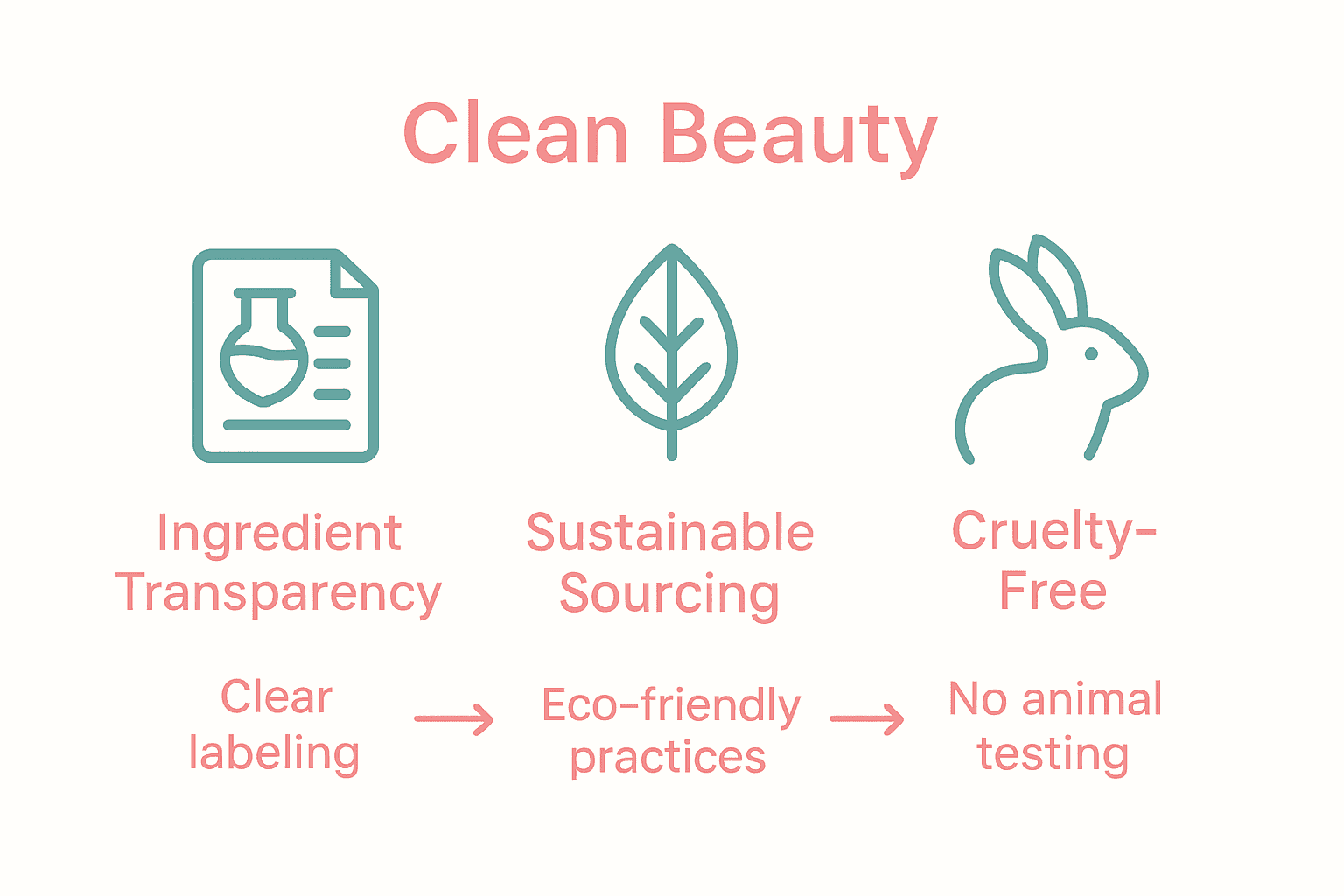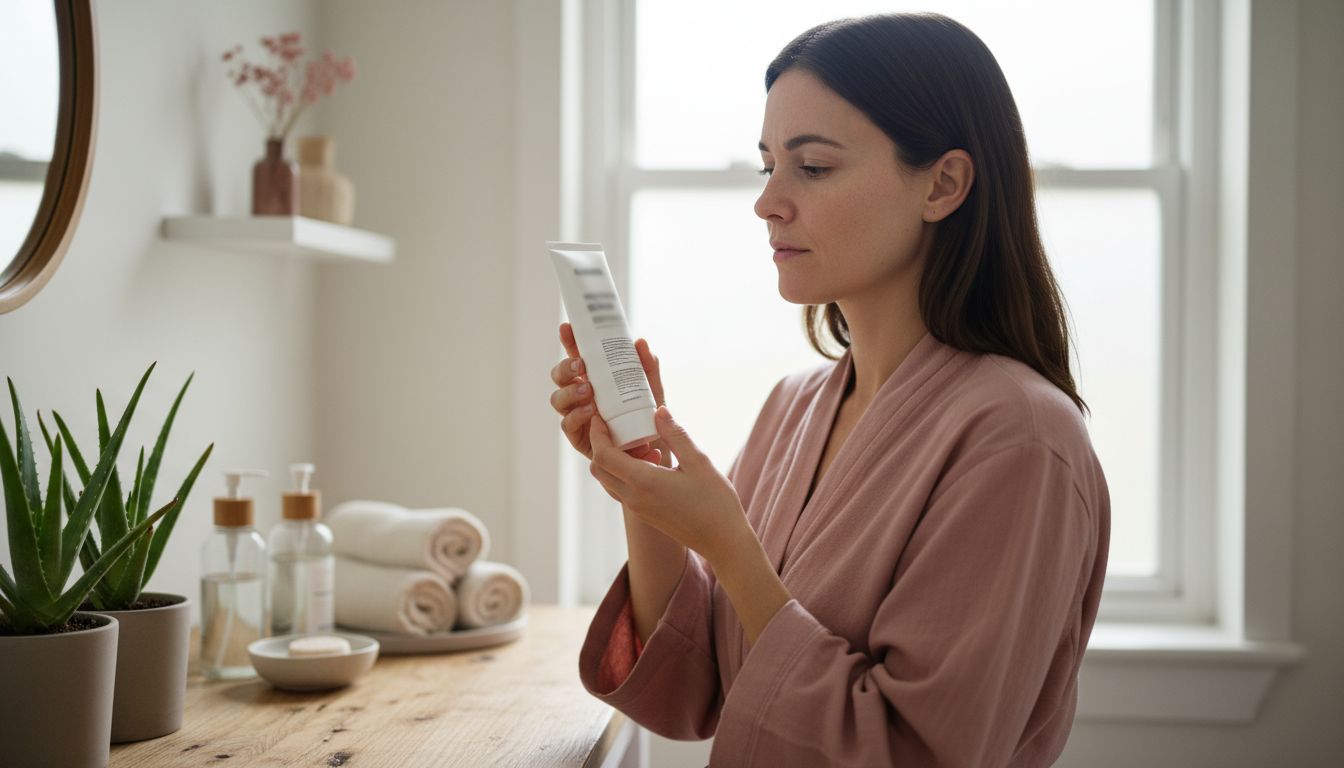Nearly 60 percent of what you put on your skin can be absorbed into your body, yet most people rarely question the safety of their everyday beauty products. With so many labels boasting ‘natural’ or ‘clean’, it can be tricky separating genuine wellness from clever marketing. Understanding the clean beauty movement means discovering how ingredient transparency and smart choices can reshape both personal health and the world around you.
Table of Contents
- Defining The Clean Beauty Movement
- Common Ingredient Myths And Misconceptions
- Core Standards And Labeling Explained
- Benefits For Sensitive And Holistic Consumers
- How To Identify And Choose Clean Beauty Products
Key Takeaways
| Point | Details |
|---|---|
| Holistic Approach to Beauty | The clean beauty movement emphasizes wellness, environmental consciousness, and ethical sourcing alongside effective beauty results. |
| Ingredient Transparency is Key | Consumers should prioritize products with clear ingredient lists and avoid potentially harmful chemicals like parabens and sulfates. |
| Myth-Busting Chemical Misconceptions | Not all natural ingredients are safe, and synthetic ingredients can be safe and effective; consumers must navigate myths around ingredient safety. |
| Informed Product Choices | Selecting clean beauty products requires careful investigation of brand values, ingredient functions, and third-party certifications. |
Defining the Clean Beauty Movement
The clean beauty movement represents a transformative approach to personal care and cosmetics that prioritizes wellness, transparency, and intentional ingredient selection. Unlike traditional beauty paradigms that focused solely on aesthetic results, this movement emerges from a profound understanding that what we apply to our skin directly impacts our overall health. Think of it as a holistic philosophy that asks: “What are we really putting on our bodies?”
At its core, clean beauty centers on creating products free from potentially harmful ingredients like parabens, sulfates, synthetic fragrances, and other contentious chemical additives. Understanding the nuances of clean beauty ingredients reveals a commitment to consumer safety and environmental consciousness. The movement champions transparency, inviting consumers to become informed participants in their personal care choices rather than passive recipients of marketing narratives.
The landscape of clean beauty is complex and evolving. While there’s no universally standardized definition, most proponents agree on several fundamental principles:
- Prioritizing natural and organic ingredients
- Avoiding potentially toxic synthetic chemicals
- Ensuring ethical and sustainable sourcing practices
- Maintaining transparency about ingredient origins and manufacturing processes
- Supporting cruelty-free and environmentally responsible production
What sets clean beauty apart is its holistic perspective. It’s not just about eliminating harmful ingredients but about creating a comprehensive approach to beauty that considers personal health, environmental impact, and ethical production simultaneously. This isn’t merely a trend—it’s a fundamental reimagining of our relationship with personal care products.
Common Ingredient Myths and Misconceptions
In the world of clean beauty, ingredient myths can be more pervasive than the ingredients themselves. Many well-intentioned consumers navigate a complex landscape of marketing claims, scientific jargon, and conflicting information that can make understanding product safety feel like solving an intricate puzzle. The reality is that not all “natural” ingredients are inherently safe, and not all synthetic components are harmful.
One prevalent misconception is the automatic assumption that “clean” or “natural” labels guarantee absolute safety. Learn more about decoding beauty ingredient terminology to understand the nuanced reality. Research indicates that many beauty products labeled as “clean” can still contain potential allergens, particularly in fragrances and botanical ingredients. This challenges the simplistic narrative that natural automatically means better or safer for your skin.
Common ingredient myths include:
- Natural Always Means Safe: Some natural ingredients can be highly allergenic or irritating
- Chemical-Free Products Exist: Every substance is technically a chemical, making this claim scientifically impossible
- More Expensive Equals Higher Quality: Price doesn’t guarantee effectiveness or safety
- Organic Labels Prevent All Skin Reactions: Organic ingredients can still cause allergic responses
- All Synthetic Ingredients Are Harmful: Many synthetic ingredients are carefully developed for safety and effectiveness
Understanding ingredient complexity requires moving beyond binary thinking. Consumers need to become informed investigators, reading labels, understanding ingredient functions, and recognizing that safety is about careful formulation rather than blanket categorizations. The goal isn’t to fear ingredients but to approach them with curiosity, critical thinking, and an appreciation for the nuanced science behind skincare and cosmetic development.
Core Standards and Labeling Explained
Navigating the complex world of clean beauty standards can feel like deciphering an intricate code. Unlike traditional cosmetic regulations, clean beauty doesn’t have a single, universally accepted certification. Instead, it represents a nuanced approach to product development that prioritizes transparency, safety, and ethical considerations beyond conventional industry standards.
Learn more about clean beauty labeling terminology to understand the subtle distinctions that define this movement. The core standards typically revolve around several key principles that differentiate clean beauty products from conventional alternatives. These standards aren’t just about eliminating harmful ingredients, but about creating a holistic approach to beauty that considers human health, environmental impact, and ethical production simultaneously.
The most critical elements of clean beauty standards include:

- Ingredient Transparency: Complete disclosure of all product components
- Restricted Ingredient Lists: Proactively avoiding known harmful substances
- Minimal Processing: Preserving the integrity of natural ingredients
- Sustainable Sourcing: Ensuring ethical and environmentally responsible procurement
- Cruelty-Free Certification: Guaranteeing no animal testing throughout production
However, it’s crucial to recognize that clean beauty labeling remains largely unregulated. This means consumers must become informed investigators, understanding that labels like “natural” or “clean” aren’t legally defined terms. The absence of standardized regulations creates both opportunity and challenge, empowering brands to innovate while simultaneously requiring consumers to dig deeper, read ingredient lists carefully, and look beyond marketing claims to truly understand what goes into their personal care products.
Benefits for Sensitive and Holistic Consumers
For individuals with sensitive skin, the clean beauty movement represents more than just a trend—it’s a lifeline of hope and healing. Traditional cosmetic products often feel like a minefield of potential irritants, with synthetic chemicals that can trigger inflammation, allergic reactions, and long-term skin damage. Clean beauty offers a compassionate alternative, focusing on ingredients that nurture and support the skin’s natural balance.
Discover seven specialized types of clean beauty for sensitive skin relief to understand how holistic approaches can transform your skincare routine. Beyond physical benefits, clean beauty speaks to a deeper philosophy of wellness that considers the interconnectedness of personal health, environmental sustainability, and ethical consumption. For holistic consumers, each product becomes a conscious choice that reflects their values of self-care, planetary responsibility, and mindful living.
The key benefits for sensitive and holistic consumers include:
- Reduced Skin Irritation: Minimizing exposure to harsh synthetic chemicals
- Improved Skin Microbiome: Supporting the skin’s natural protective mechanisms
- Emotional Well-being: Creating a sense of safety and intentionality in personal care
- Environmental Consciousness: Supporting brands with sustainable and ethical practices
- Holistic Health Alignment: Choosing products that contribute to overall wellness
Holistic consumers understand that beauty is not just skin deep. It’s a reflection of inner health, personal values, and a commitment to nurturing both personal and planetary well-being. By choosing clean beauty, they’re not just selecting a product—they’re participating in a movement that reimagines beauty as an act of self-love, environmental stewardship, and conscious living.

How to Identify and Choose Clean Beauty Products
Choosing clean beauty products requires more than just scanning labels—it demands a detective-like approach to understanding ingredient lists, brand philosophies, and hidden complexities of cosmetic formulations. The journey begins with recognizing that not all marketing claims are created equal, and the word “natural” doesn’t automatically guarantee safety or effectiveness.
Explore our comprehensive guide to non-toxic beauty essentials to develop a more nuanced understanding of product selection. The clean beauty landscape is a maze of claims, certifications, and varying standards, making informed choices crucial for those committed to holistic wellness. Consumers must become empowered investigators, looking beyond surface-level promises to understand the deeper narrative of their personal care products.
Key strategies for identifying genuine clean beauty products include:
- Read Ingredient Lists Thoroughly: Avoid products with parabens, sulfates, synthetic fragrances
- Research Brand Transparency: Choose companies that openly share sourcing and manufacturing practices
- Look for Third-Party Certifications: Seek cruelty-free, organic, or verified clean beauty badges
- Understand Ingredient Functions: Know the purpose and potential impact of each component
- Consider Skin Sensitivity: Prioritize gentle, non-irritating formulations
Ultimately, choosing clean beauty is about creating a personal care ritual that aligns with your values of health, sustainability, and conscious consumption. It’s not just about what you put on your body, but about supporting a broader movement that values transparency, ethical production, and holistic well-being. Each product becomes a statement—a small but powerful choice to nurture yourself and the planet simultaneously.
Embrace Clean Beauty with Confidence and Care
The clean beauty movement invites you to choose products that nourish your skin and soul while steering clear of harmful chemicals like parabens and synthetic fragrances. If you struggle with sensitive skin or want to invest in cosmetics that align with your holistic values, Pure Light Botanical Beauty offers a thoughtful solution. Our plant-based formulas support skin healing and celebrate your natural radiance without compromise. Discover how transparency, sustainability, and gentle ingredients come together to transform your personal care ritual.

Take the next step toward safe, effective clean beauty by exploring our collection at Pure Light Botanical Beauty. Learn more about how clean, nourishing makeup can enhance your wellness journey in our blog on clean beauty terminology explained and deepen your understanding with our non-toxic beauty guide. Now is the perfect time to embrace products that honor both your sensitive skin and your values. Visit our site and experience a new standard of natural beauty care.
Frequently Asked Questions
What is the clean beauty movement?
The clean beauty movement emphasizes using personal care and cosmetic products free from harmful ingredients, focusing on wellness, transparency, and ethical practices in ingredient sourcing and production.
What are the common ingredients to avoid in clean beauty products?
Common ingredients to avoid include parabens, sulfates, synthetic fragrances, and other potentially harmful chemical additives that can irritate the skin or pose health risks.
How can I identify if a beauty product is genuinely clean?
To identify clean beauty products, read ingredient lists thoroughly, research brand transparency, look for third-party certifications, and understand the functions of various ingredients.
Are all natural ingredients safe for my skin?
No, not all natural ingredients are safe; some can be allergenic or irritating. It’s essential to evaluate each ingredient’s specific effects on the skin rather than assuming that natural means safe.
Recommended
- Advantages of Clean Cosmetics: Complete Guide – Pure Light Botanical Beauty
- What Is Clean Label Beauty? Complete Overview – Pure Light Botanical Beauty
- The Essential Guide to Clean Cosmetics Benefits – Pure Light Botanical Beauty
- Complete Guide to the Advantages of Clean Cosmetics – Pure Light Botanical Beauty
